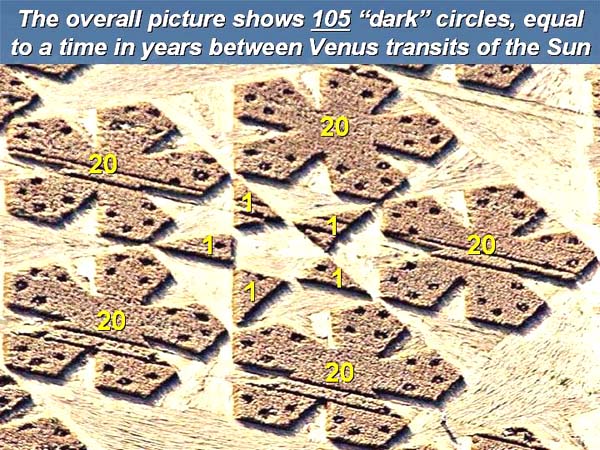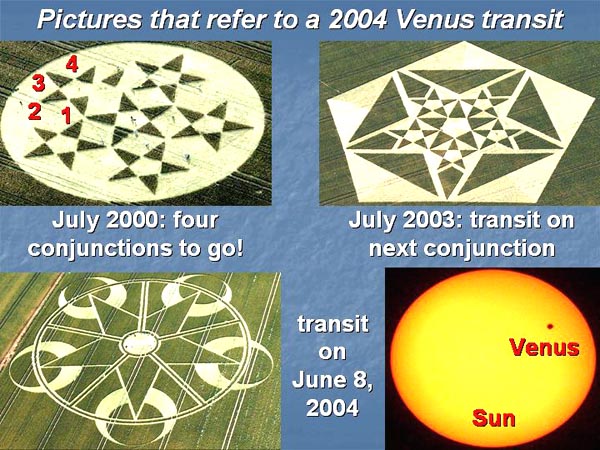|
Chute Causeway and the Sun-Venus calendar: precise calculations of astronomical time from 1997 to 2013
"When European scholars began decoding
ancient Mayan hieroglyphs, their earliest successes were in
understanding the numbering systems used by the Mayans, as well as
their calendar systems which were based on visible motions of the
Moon, Sun or Venus. In short, math and science provided the
foundation for further communication, just as many SETI scientists
predict will be the case for interstellar communication."---
www.seti.org, "Decoding E.T. in Search of a Cosmic Rosetta
Stone"
Over the past year, it has become abundantly
clear that modern crop pictures are a real SETI-type phenomenon, as
witnessed for example by the sudden appearance of a 1 km long crop
picture at East
Field on July 7, 2007 at 3:14 AM, after a brief microsecond
flash of "sheet lightning" above the field that was captured on
camera
(www.gazetteandherald.co.uk/news/headlines/display.var.1559662.0.the_crop_circle_mystery.php or www.earthfiles.com/news.php?ID=1288&category=Environment).
In fact, fifty or more authentic crop pictures
seem to appear every summer all across Europe, although mainly
within a small region of southern England near
Avebury. Knowledgeable experts currently believe that only 5-20% of
those could be locally man-made. With such experimental facts in
hand, one might suppose that modern crop pictures would be regarded
as one of the greatest scientific challenges of our time! Instead,
the subject remains little discussed except in local newspapers; and
most professional scientists continue to know little or nothing
about it.
In addition to being "real", modern crop
pictures also seem to represent a form of "intelligent
communication" from scientists who live in another space or
time to ourselves. Finally, such highly-patterned messages do not
actually seem to come from extra-terrestrial aliens, as some people
believe, but rather from another human-like culture who may live
in our distant past, or perhaps in another historical timeline or
dimension on Earth? Thus, modern crop pictures are often
"associated with ancient sites or knowledge". Since those crop
pictures are demonstrably real, and represent some form of
intelligent communication between other scientists and ourselves,
shouldn't we at least try to understand what they are telling us?
In previous work, some of us studied a variety of
complex crop pictures from 1990 to 2007 that describe solar
astronomy, lunar astronomy, yearly calendars, sacred geometry or
long-forgotten archaeological information (summarized in Table II
below). Here I will analyze another important series of crop
pictures that describe the astronomy of Venus (mainly its transits
or conjunctions as seen from Earth), as well as the Sun-Venus
calendar that they use to date events in our modern world.
An ancient pentagram symbol for Venus
The traditional symbol for Venus
has always been that of a five-pointed star or pentagram, owing to
the peculiar nature of its 225-day orbit around the Sun as seen from
Earth (www.eso.org/public/outreach/eduoff/vt-2004/Education/edu1app5.html). And
indeed, those unknown crop artists often use a pentagram symbol when
describing Venus, for example in its close-sky approaches or
conjunctions with the Sun or Moon as seen from Earth:
The "beaded spiral" symbols shown in the lower
part of that diagram above were also used to depict monthly phases
of our Moon at
Stonehenge 1996, Windmill Hill 1996,
Chiseldon 1996 and Milk
Hill 2001.
Other crop pictures show the pentagram symbol for
Venus on its own, in the absence of other heavenly bodies such as
the Moon or Sun. Those Venus-only pictures sometimes include
additional representations of the numbers "8" or "13", in order to
express certain fundamental relations from astronomy concerning
Venus orbit as seen from Earth, versus Venus orbit as seen from the
Sun:
The relevant astronomical facts are
as follows:
(i) five cycles of Venus orbit as
seen from Earth = 5 x 583.92 = 2920 days;
(ii) eight Earth years = 8 x 365.25
= 2922 days;
(iii) thirteen cycles of Venus
orbit as seen from the Sun = 13 x 224.70 = 2921 days
In other words, Venus requires 225
days to orbit the Sun as seen in a Sun-centred heliocentric
perspective, but requires a somewhat longer 584 days to orbit the
Sun as seen in an Earth-centred geocentric perspective; because
Earth is moving in the same angular direction around the Sun as is
Venus, except more slowly.
Chute Causeway 2007 as a pentagram artwork featuring
Venus astronomy
Now apart from its two most common
uses to mark conjunctions of Venus, or to teach simple Venus
astronomy, that ancient pentagram symbol has also been used over the
years to represent certain complex aspects of Venus
astronomy: namely its rare transits across the face of the Sun, once
every 105.5 or 121.5 years. One such pentagram artwork appeared at
Chute Causeway in late July of 2007. There we can see many different
pentagram symbols in combination, as five around the
outside plus five more along the inside:
Furthermore, the entire
picture has been designed as a
kind of optical illusion, so that it may
be perceived as either "light"
or "dark". The crop artists
seemingly intended us to study their design from two different
visual perspectives! When seen as "light", one can count 225
small circles across the entire diagram, thereby matching how many
days it takes Venus to complete one orbit as seen from the Sun:
But when
seen as "dark", those 225 small circles become sub-divided into
smaller groups of either 105 or 120:
In fact,
those two numbers 105 and 120 closely match how many years it
takes Venus to repeat its infrequent eclipse or "transit" across
the face of our Sun as seen from Earth:
In summary,
Chute Causeway seems to describe two different aspects of Venus
astronomy, depending on whether we view the picture as "light"
or "dark".
Other commentaries on Chute Causeway
Two other
interesting analyses of that same crop picture have been posted
on
www.cropcircleconnector.com, "Late July", concerning its
possible spiritual aspects: "The Fractal of Man" by Rod
Bearcloud, or "Earth Log July 2007" by Celia Fenn. In
his essay, Bearcloud notes eloquently:
"While such star-glyphs (crop pictures) can be understood with
no meaning attached at all, at the same time a meaning can often
be derived from ancient understandings. When a symbol is not
defined, it can still assist in our world by seeing it as a
symbolic reference in spirit. Yet I wonder where my people would
be today, if the medicine wheel had never had a meaning attached
to it, and was just left as something to be viewed?"
Venus transits
from 2012 or 2004 portrayed in crops
Why
would those crop artists show a complex pentagram artwork in
July 2007, describing Venus transits of our Sun? It may
be because 2007 lies almost halfway in time between two rare
transits of our Sun on June 8, 2004 and later June 6,
2012. A near-future transit of Venus in June of 2012 was
referred to specifically by a simple yet elegant crop
picture from Stanton St. Bernard in August 2007, which
showed the Mayan symbol for "six":
Indeed, as of August 18, 2007, there were precisely "six
Venus conjunctions left to go" until it enters transit 6 x
292 = 1752 days later on June 6, 2012. A past transit of
Venus in June of 2004 was likewise referred to by several
crop pictures from 2000 or 2003:
To
conclude: Venus conjunctions, orbital astronomy and transits
all seem to play an important role in modern crop pictures.
But why?
A
second kind of Venus
symbolism used
to portray the Mayan Calendar Round
Apart from facilitating SETI-type communication between
our two cultures, by showing us facts that we already
know, the frequent appearance of Venus in modern crop
pictures may perhaps be related to the time-keeping
scheme of those crop artists in our modern era. For
whatever reason, they seem to favour an ancient Mayan
time-keeping scheme known as the "Calendar Round" (http://en.wikipedia.org/wiki/Maya_calendar):
Above in
oilseed rape from 1998, we see a classic Calendar Round with
33 (or 32.5) angular divisions. That particular number
of divisions always symbolized a long-term periodicity of
Venus in Mayan-Aztec culture. To be more specific, Venus
completes any single orbit about the Sun as seen from Earth
in 584 days; and hence will complete 32.5 orbits in 32.5 x
584 = 18,980 days, which is close to 52 solar years (18,993
days).
Then in
two subsequent pictures from 2003, the crop artists showed
us how they keep time in our modern era by means of a
Sun-Venus calendar. Their first picture showed a 32-cycle
long-term periodicity of Venus on the inside (yellow
numbers), that should last for 52 Earth years (red numbers
outside) as one complete Calendar Round:
Their second picture showed a 65-cycle long-term
periodicity of Venus (yellow numbers outside, red
numbers inside) that would last for 2 x 52 = 104 Earth
years as two Calendar Rounds, if it were carried to
completion:
Yet
as of August 2003 when that second picture appeared,
their current 104-year calendar had apparently not yet
been completed, because its red numbers only go up to
"59" rather than to "65"! Also, only four S-shaped
symbols for Venus appear along the inside, whereas two
full Calendar Rounds would have shown ten. The remaining
amount of calendar time should therefore equal 65 - 59 =
6 cycles of Venus, where 6 x 584 = 3504 days or 9.6
years.
We
know that the Mayan Long Count will end in late December
of 2012. There will be a Sun-Venus conjunction only a
few months later on March 28, 2013. Could both their
Long Count and Sun-Venus calendars end together? If we
add 9.6 years as just calculated to August 2003, we find
2003.65 + 9.6 = 2013.25 or late March 2013, which is
close to when Venus will enter superior conjunction with
the Sun as seen from Earth.
Other commentaries on Venus and the Calendar
Round
"No
day-name in the Calendar Round was repeated before a
complete sequence of combinations had occurred over 52
years, or 52 x 365 = 18,980 days. That period of time is
also equal to 32.5 orbital periods of Venus or 32.5 x
584 = 18,980 days. A Venus Table from the Dresden Codex
lasted exactly twice as long as any Calendar Round, and
thus covered a period of 104 years, equal to 65 orbital
periods of Venus or 37,960 days."---or
www.geocities.com/Athens/Delphi/9976/mayan5.html
Part
of the ancient Venus Table is shown below:
"In
the Venus Table from the Dresden Codex, the first date
in the first row corresponds to a superior conjunction
of Venus. The second date, 90 days later, corresponds to
its rise as an evening star. The third date, 250
days later, tells when Venus disappears at inferior
conjunction. The fourth date, 8 days later, marks
its rise as a morning star. The next cycle begins
with another superior conjunction."---http://members.shaw.ca/mjfinley/4VENUS.htm
A Sun-Venus
calendar: how those crop artists "count
time" in our
modern era from 1997 to 2013
The single calculation given
above, concerning start and end-dates for a crop-based Sun-Venus
calendar, seemed promising but not conclusive. Yet if we now
carry out that same kind of analysis on many different crop
pictures that have appeared over the years, and combine the
information given by each one into a coherent whole, then we
can easily arrive at a fairly good idea of how those crop
artists "count time" in our modern era from 1997 to 2013.
Both
conjunctions and transits of Venus seem
to play a major role in
such time-keeping. An
"inferior conjunction"
is when Venus comes between the
Sun and Earth. A "superior conjunction"
is when the Sun comes between Venus and Earth. A "transit" is
a special kind of inferior conjunction, where Venus eclipses
part of the Sun as seen from Earth.
Conjunctions happen once every 292 days, whether inferior or
superior. The time between any two conjunctions of the same
kind is 584 days. The time between transits may be either 105.5
or 121.5 years, and then they occur in "pairs" separated by 8
years.
I will give below a brief
verbal description of each crop picture studied, with the goal
of deriving more information about their Sun-Venus calendar.
A concise summary of all mathematical results will be provided
further below in Table I.
July 1997, Etchilhampton Hill:
26 x 30 = 780 weeks or 15 years left until a transit of Venus in
June 2012. In other words,
1997.5 + 15.0 =
2012.5. (The Mayans used 13 or
20-day weeks. Presumably this early calculation using 7-day weeks
was to help us understand.)
August 2, 2003, East Field: 59 out
of 65 Venus cycles from our current 104-year Mayan
calendar have already been
used, leaving just 6 cycles of 584 days = 3504 days or
9.59 years until an
end to that calendar on March 28, 2013 (superior conjunction). In
other words, 2003.65 + 9.59
= 2013.24.
August 18, 2003 or 2003.65 was
a superior conjunction close
to when that crop picture appeared.
August 2, 2004, Silbury Hill: a Mayan
Sunstone picture suggests that only 52 / 6 = 8.67
years remain until our current 52-year
calendar ends on March 28, 2013 (superior conjunction). In
other words, 2004.57 + 8.67 = 2013.24.
August 2, 2004 or 2004.57 was
when that crop picture appeared. Our current 52-year
calendar would presumably
begin on April 10, 1961
or precisely 18,980 days earlier (inferior conjunction).
August 9, 2005, Wayland's Smithy: another Mayan
Sunstone picture uses our
current 52-year calendar to define a series of hexadecimal
dates that start apparently with "0-0-0" on
April 10, 1961 (inferior conjunction)
and end with "16-0-0" on
March 28, 2013 (superior conjunction).
Then it gives a reference date of "13-10-7" that translates precisely
to August 9, 2005 when that crop picture appeared
(to help us understand their math), plus an event date of
"14-5-11" that translates to November 21, 2007 plus or minus two
days. What might happen then?
July 8, 2006, Wayland's Smithy: a series
of astronomical rays were shown proceeding outward in three
directions x, y, z from a central source, possibly
our galactic centre. The
three longest showed an
approximate 7 x 8 = 56 grid at
each square end. Yet each of
those rays could have shown
a perfectly-square 8 x 8 = 64
grid, to portray the
number of Venus conjunctions in our current
52-year calendar (65 in
total, or 64 until transit). Hence there were apparently 64 -
56 = 8 left as of July 2006, equal
to 8 x 292 = 2336 days or 6.40 years.
When we add 6.40 years to July 2006, we find a near-future date of
2006.6 + 6.4 = 2013.0, that lies close to the winter solstice of
December 2012.
August
12, 2007, Stanton St. Bernard: an
ancient Mayan symbol for
"the number six" provided
us with two overlapping meanings. First, it marked
six days left until the next conjunction of Venus on August 18, 2007
(inferior). Secondly, it marked
six conjunctions left until a transit of Venus on June 6, 2012.
In other words,
2006.63 + 4.80 =
2012.43.
Table I. Examples of modern crop pictures that seem to use a Sun-Venus calendar
We are being sent
SETI-type messages in English fields, but will anyone listen?
Whatever your thoughts may have
been concerning modern crop pictures, prior to reading this
analysis, hopefully they will become more accurate and factual in
the future. The vast majority of Earth's population has until
recently been misinformed. .
We are clearly being sent SETI-type
messages in English fields: starting in the late 1980's, then
continuing each year from 1990 to 2007. There is every indication
that such crop-based messages will continue until at least 2013,
judging from the nature of their Sun-Venus calendar as described
above.
We do not yet understand how
ancient Mayan-Aztec culture could be exerting such a strong
influence on many of those crop messages. One possibility is that
such messages come from our distant past, when Mayan and British
megalithic cultures may have been in close contact. Another
possibility is that they come from an alternative historical
timeline on Earth: one in which Spanish invaders did not destroy an
already-advanced central American culture in 1520, thereby allowing
it to continue into the future?
Whatever the final answer to these
difficult questions may be, it should be noted here that a large
number of modern crop pictures have already been elucidated in part,
and not just the Sun-Venus ones discussed above. Most of the others
recount ancient knowledge that was present throughout the British
Isles, Europe or Egypt 4000 to 5000 years ago, and are summarized
briefly in Table II below. For a more complete description, one
should consult
www.cropcircleconnector.com or its archives.
Table II. A brief summary of modern crop pictures and their diverse subject matter
Red Collie |













